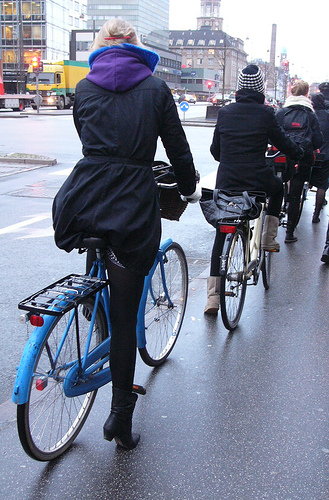He loves paradox and his subject yields up many, and partly for this reason I found it poignant that my burg, Washington DC, a car-mad city, was host recently to a National Bike Summit at which Andreas Røhl, the head of Copenhagen’s Bicycle Office, detailed how very different things could be.
It's easy to think, and say, dismissively, "well Copenhagen, what have we in common with that place?" But it takes little research to uncover some big time commonalities. Both C and DC are capitol cities, both have about the same population size, their climates are similar (C's is a bit colder and wetter and, being farther north, its winter nights are longer). Both have wealthy, mostly liberal and forward thinking, clusters of residents. From a cyclist's point of view, DC has the advantage in its compactness, but C is a bit flatter. C, overall, is safer, but DC's crime is largely located outside the areas where its upscale residents live and work.
So... Why is DC's bike policy so lame? (Not nonexistent, I'm happy to say, but truly lame all the same.)
Here's what Copenhagen can brag about.
First, a write up of Røhl's presentation from the Examiner newspaper: Best of Copenhagen bike manager's address to National Bike Summit attendees
Second, a compelling photo of bikes parked at a transit station in Copenhagen:

Third, a photoblog of cycling-chic in Copenhagen: Copenhagen Cycle Chic - Streetstyle and Bike Advocacy in High Heels
Fourth, a Copenhagen bike advocacy blog: Copenhagenize
Fifth, here are extracts from the roundup on The Wash Cycle, DC's advocacy blog:
National Bike Summit Summary
I went to several free components of the National Bike Summit, but I had work to do that week so I couldn't attend much. Luckily many other people have twitblogged about it on the interspace. First Adam Voiland wrote about the Tuesday night presentation by Andreas Røhl, the head of Copenhagen’s Bicycle Office, and I watched a similar presentation by Rohl on Wednesday night. Some highlights we both gleaned.There are about 500,000 bikes in Copenhagen. 25% of people now have cargo bikes and that is requiring them to build unique facilities to handle them. 60% of voters own bikes.GGW found this highlight
As of 2003, there's more bike traffic in downtown that automobile traffic, meanwhile safety has increased (there were 50% fewer deaths in 2003 than in 1995). The more cyclists there are the fewer accidents they have, because, he theorizes, people get used to it. They still have less than half as many cyclist as they did in 1950.
He listed the usual reasons to encourage biking: less congestion, a better environment, better health, improvement of urban life, bike changes can be implemented in a single election cycle, they're cheap and have visible effects, they reduce CO2 footprint.
They've calculate that every mile biked gives $1 in health benefits. “A 10 percent increase in cycling would save $10 million per year”
They've been instituting a Green Wave (which means retiming lights for "cyclist speed" on certain streets. This reduces travel time by 15% and makes cycling more pleasant since cyclists use less energy). They're also pulling the ASL line back for motorists, so that cyclists (who are usually placed to the right, in their own lane) are clearly visible and ahead of the motorists. This reduces the chances for right-turning cars to hit straight-going cyclists. They're also creating carless streets (which allow buses, cyclists and pedestrians).
Bike parking at train stations is a serious problem, because the train stations are handled by the National government.
The average bike trip is around four miles.
“Nobody in Copenhagen sees themselves as a 'cyclist.'"
"In the last 15 years the distance traveled on bicycle has risen by 15 percent.”One of Røhl's many interesting statistics came from a biennial survey of Copenhagen cyclists. When asked for the primary reason why they bicycle, a combined 61 percent of respondents said it was either because cycling was easy and fast or because it was the most convenient mode of transportation. 19 percent cited exercise, 6 percent pointed to financial reasons and a paltry 1 percent were motivated by environmental concerns.For more on Copenhagen you can check out presentation here, here and here. And for full coverage of Røhl's talk go to bikeportland.
Røhl's conclusion was that, in order for cycling to become a mainstream transportation option, it has to be promoted and planned for based primarily on its convenience.
Additional Links:
Cycling in Copenhagen
Copenhagen, City of Cyclists (pdf)
Livable Copenhagen: The Design of a Bicycle City (pdf)
More Copenhagen cycling photos:





 '
'Comparing DC and Copenhagen:
Copenhagen has a population of 530,000 residents. It occupies 175 sq. mi. and is located on 12.58 degrees longitude, and 55.67 latitude. Washington, D.C. has a population of 570,900 residents. It occupies 68 sq. mi. and is located on -75.02 degrees longitude, and 38.82 latitude. Both have copious land set aside for parks. Both are national capitals. Both have moderate climates (although Copenhagen is colder and wetter). Washington has potential advantages of smaller area and greater population density. However, it has a lower per-capita standard of living and, of course, lacks commitment to cycling.




2 comments:
it would be lovely if you credited all the photos after the blog post as Photo: Mikael Colville-Andersen / Copenhagen Cycle Chic.com
except the very last one.
thanks.
Thanks Mikael, I've done that.
Post a Comment